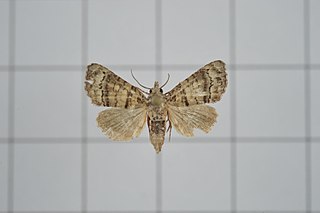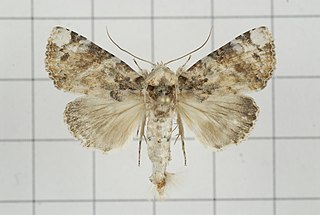
Chlumetia transversa, the mango shoot borer, is a moth of the family Euteliidae. The species was first described by Francis Walker in 1863. It is a widely distributed across Indo-Australian tropical countries far east to Solomon Islands.
Aquis orbicularis is a moth of the family Nolidae first described by Francis Walker in 1858. It is found in the Indian subregion, Sri Lanka, Peninsular Malaysia, Papua New Guinea and Borneo.
Giaura tortricoides is a moth of the family Nolidae first described by Francis Walker in 1865. It is found in Sri Lanka, Japan, Andaman Islands, Borneo, Sumatra, Flores, Sulawesi, New Guinea, Bismarck Islands and Australia.
Lophothripa vitea is a moth of the family Nolidae first described by Swinhoe in 1885. It is found in Indo-Australian tropics towards the Solomon Islands.

Maceda mansueta is a moth of the family Nolidae first described by Francis Walker in 1857. It is found in Japan, Sri Lanka, Borneo, India (Andamans), Malaysia, New Guinea, Fiji, Australia, Réunion and the Seychelles.

Maurilia iconica is a moth of the family Nolidae first described by Francis Walker in 1857. It is found in Indo-Australian tropics of Sri Lanka, Australia to the islands of Samoa, Rarotonga and New Caledonia.
Nycteola indicatana is a moth of the family Nolidae first described by Francis Walker in 1863. It is found in the Indian subregion, Sri Lanka, Singapore, Borneo, Java and the Solomon Islands.

Paracrama dulcissima is a moth of the family Nolidae first described by Francis Walker in 1864. It is found in Indo-Australian tropics of India, Sri Lanka and the Bismarck Islands.
Etanna basalis is a moth of the family Nolidae first described by Francis Walker in 1862. It is found in Borneo, Sri Lanka, Myanmar, Thailand, New Guinea, Australia, Vanuatu and Fiji.
Lasiolopha saturata is a moth of the family Nolidae first described by Francis Walker in 1865. It is found in Oriental tropics of India, Sri Lanka, Thailand, New Guinea and Australia.
Selepa discigera is a moth of the family Nolidae first described by Francis Walker in 1864. It is found in Oriental tropics of India, Sri Lanka, New Guinea and Australia.
Selepa plumbeata is a moth of the family Nolidae first described by George Hampson in 1912. It is found in Oriental tropics of India, Sri Lanka, and Borneo.

Earias cupreoviridis, called the cupreous bollworm as a larva, is a moth of the family Nolidae. The species was first described by Francis Walker in 1862. It is found in African countries like Botswana, the Democratic Republic of the Congo, Eritrea, Ethiopia, the Gambia, Kenya, Nigeria, Sierra Leone, South Africa, Togo, Uganda, Zimbabwe to Asian countries like India, Sri Lanka, China, Japan, Korea, Philippines, Indonesia and Hong Kong.
Beara dichromella is a moth of the family Nolidae first described by Francis Walker in 1866. It is found in Sri Lanka, and India.

Beana terminigera is a moth of the family Nolidae first described by Francis Walker in 1858. It is found in India, Sri Lanka, Nepal, Thailand, Myanmar, Peninsular Malaysia, Borneo and the Philippines.
Labanda saturalis is a moth in the family Nolidae first described by Francis Walker in 1865. It is found in Indo-Australian tropics of India, Sri Lanka, and from New Guinea to the Solomon Islands.
Nola analis is a moth of the family Nolidae first described by Wileman and West in 1928. It is found in India, Sri Lanka and Hong Kong.
Nola lucidalis is a moth of the family Nolidae first described by Francis Walker in 1864. It is found in the Indian subregion, Sri Lanka, Borneo, Java, the Philippines and Taiwan.
Nola mesotherma is a moth of the family Nolidae first described by George Hampson in 1909. It is found in Sri Lanka.
Nola rufimixta is a moth of the family Nolidae first described by George Hampson in 1909. It is found in India and Sri Lanka.







